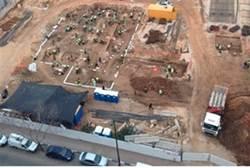Archaeologists find advanced pulley system, irrigation ducts in the heart of Tel Aviv.
Tova Dvorin
Source - http://www.israelnationalnews.com/News/News.aspx/177125#.UvJsOPl5PVQ

Ramat HaChayal excavation site Karmi Ginsberg
A large and impressive well was discovered in the Tel Aviv neighborhood of Ramat HaHayal Wednesday, a find archaeologists say dates back at least 1,400 years.
Archaeologists uncovered the well in the course of a wider salvage excavation project by the Israel Antiquities Authority(IAA) on Barzel Street, as a preparatory measure before establishing a hospital on the site by the Sufrin Group real estate company.
The well dates back to the Byzantine and Early Islamic periods - between 1,100 and 1,400 years ago, according to the IAA.
"The well, known as an 'Antilla' well, is the first of its kind found in Tel Aviv," Eli Haddad, director of the excavation on behalf of the IAA, stated. "The importance of the discovery is that it adds information about everyday life in the Yarkon 1,400-1,200 years ago, including agriculture."
"Pumping systems of this type were in the country starting from the Roman period (2,000 years ago) onwards, but few have been studied in depth," he continued. "Other discoveries have been made in Tel Ashdod, Yavne-Yam (now near Kibbutz Palmahim) and Ramle."
"In addition, we have found other wells along the coastal plains, in Atlit and Acco. Wells like these were also restored recently in Neot Kedumim and Nes Ziona," Haddad added.
"This well was considered state-of-the-art at the time," Haddad explained. "Unlike earlier wells which had people drawing water themselves, these wells had a system where animals moved a pumping mechanism to provide water for drinking, animals, and agriculture."
The well is located about 150 meters from the Yarkon river, and extends down to the groundwater, which is probably at a depth of more than 9 meters, and consists of a vertical shaft with a diameter of about 3.5 meters. At the top of the well, around the upper wall, there are exposed notches to place wooden beams that held the water pumping system, which was operated by a wooden wheel with a rope to attach special jars or other containers to draw the water.
An animal would be tied to the rope; the owner would pull the animal away from the well, lifting the jars using the wheel and a special system of gears as pulleys. The water would then be directed via the jars through a series of channels to different areas as a means of irrigation or to provide locals with access to drinking water. So far, channels like these have been discovered up to 15 meters from the mouth of the well.
Pottery shards at the site date back to both the Byzantine and Early Islamic periods.
The floor of the water-drawing site was hewn from flagstones, and featured two compartments with a wall between them. Byzantine-era buildings have also been uncovered nearby; evidence suggests that the well was primarily in use during the Late Byzantine period, and was blocked up and filled with sand once it fell into disuse.